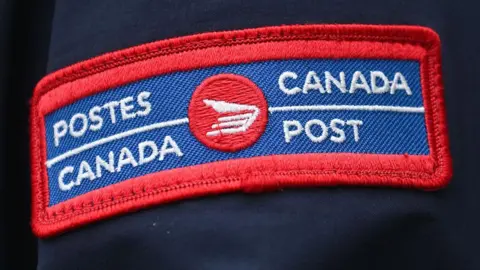 Bloomberg via Getty Images
Bloomberg via Getty ImagesPostal deliveries in Canada have ground to halt as thousands of postal workers across the country walked off the job.
The nationwide strike comes after the Canadian government authorised widespread reforms to Canada Post that would shut some post offices and end door-to-door delivery.
The Canadian postal service – like the UK’s Royal Mail and the United States Postal Service – has seen precipitous declines in letter mail delivery over the past decades and subsequent financial shortfalls.
The strike by the postal workers union also comes amid an ongoing dispute over pay and benefits that resulted in a weeks-long walkout late last year.
Prime Minister Mark Carney has said “significant changes” are necessary at Canada Post to make it “viable”.
Here’s what to know.
How will this effect mail delivery?
The nationwide strike began on 25 September and Canada Post said operations are shut down during the strike, leaving mail and parcels undelivered for millions of Canadians.
The postal service is also not offering service guarantees for items that were already in the network when the strike was called and is currently not accepting new items.
Government social security cheques will continue to be delivered, however.
Passport applications will still be processed and residents can request the document be available for in-person pick up if necessary.
 Bloomberg via Getty Images
Bloomberg via Getty ImagesWhy is there a strike?
Postal workers walked off the job to protest what the union described as “huge” service cutbacks announced by the federal government, saying they could result in major job losses.
The strike was launched just hours after the federal government announced it was authorising significant changes at Canada Post, which is a Crown corporation – a government-owned organisation that operates at arm’s length form the state and is structured like a private firm.
The new measures include ending door-to-door mail delivery to about four million homes, where they will be replaced by alternatives like community mailboxes; allowing non-urgent letter mail to be moved by ground instead of air and reducing the number of delivery days; shuttering some post offices that were in areas once rural; and giving the service more flexibility to raise prices.
Some would be phased in over the course of almost a decade.
The postal workers’ union, CUPW, called the announcement a “direct assault on our public post office, the public’s right to participate in political processes, and good, unionised jobs across the country”.
Canada Post, meanwhile, warned the strike “will further deteriorate Canada Post’s financial situation”.
This comes on the heels of a strike by postal workers last November over pay and working conditions.
In December, ahead of the busy holiday season, the Canadian government ordered the postal workers back to work.
But those issues remain unresolved and negotiations between the union and the postal service are ongoing.
When will the strike end?
That’s unclear.
Canada Post has told CUPW it plans to present new offers to the union in early October.
It had planned to submit a new offer 26 September but had to revise it following the changes announced by Ottawa.
A corporation spokesman has said in media interviews that a “wide gap” remains between the two parties over issues like part-time staffing and wage hikes.
The union and the postal service have spent nearly two years unsuccessfully bargaining for a new agreement.
On 29 September, Jobs Minister Patty Hajdu told The Canadian Press news service she hadn’t ruled out federal intervention to end this strike, but urged Canada Post to quickly table a new offer to the union.
The November 2024 strike lasted just over a month – 32 days – before the federal government legislated Canada Post employees back to work.
What this means for Canada Post
The sweeping measures to “stabilise” the postal service announced by Ottawa follow years of financial losses sustained by Canada Post, which faces reduced demand and fierce competition from private parcel delivery services.
A review of the situation at Canada Post commissioned by Ottawa in 2024 found that the postal service “is facing an existential crisis” and is “effectively insolvent, or bankrupt”.
It’s three primary revenue streams – letter mail, direct-marketing mail and parcel mail – are all in decline, either through lack of demand or through stiff competition from other courier services.
Twenty years ago, Canada Post delivered 5.5 billion letters. By 2023, that number dropped to 2.2 billion. Since 2019, its share of the parcel delivery market has also dropped from 62% to 24%.
Canada Post lost C$1bn ($717; £535m) last year and is on track to lose C$1.5bn this year, according to federal Procurement Minister Joel Lightbound.
In the second quarter of this year, it lost $407m.
In January, Ottawa loaned the corporation $1bn to help it continue operating.
CUPW has proposed the postal service explore other revenue streams, including offering banking and insurance services – a market already “well served” in Canada, according to the postal service review – and expanding into providing passport and other government services.
For its part, Canada Post has said it needs to focus efforts on core services, such as expanding parcel delivery from five to seven days a week.
This is not the first time reforms to the postal service have been put forward.
The Conservative government was moving ahead with ending door-to-door deliveries amid public opposition, but that change was paused when former Liberal Prime Minister Justin Trudeau came to power in 2015.
Source link

